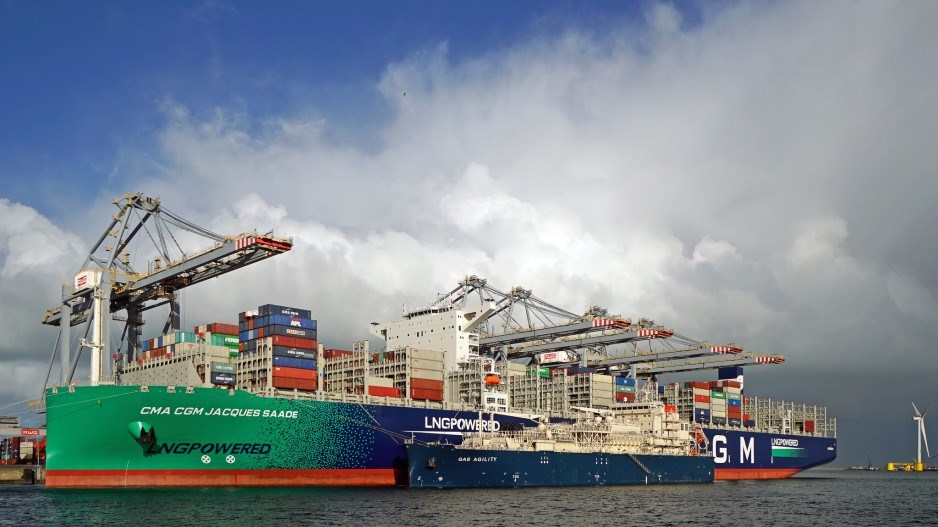The fossil fuel and shipping industries just got a serious shot across the bow over relying on liquefied natural gas (LNG) as a transition fuel.
On Friday, the International Maritime Organization (IMO) finalized stricter global emissions standards for the maritime industry while closing a significant regulatory loophole driving up the use of LNG as a shipping fuel.
LNG has lower CO2 emissions than other fossil fuels used in shipping but it also emits significant amounts of methane, a short-lived but powerful greenhouse gas responsible for more than 25 per cent of current global warming.
Past emissions rules focused solely on reducing shipping’s CO2 emissions and failed to fully include methane, which makes up 70 to 90 per cent of natural gas.
The IMO’s new emissions strategy now considers the full life cycle of shipping fuels — also known as well-to-wake greenhouse gas (GHG) emissions.
The new accounting method means LNG can no longer sail under the radar when it comes to emissions, said Elissama Menezes, global campaign director for the Say No to LNG coalition.
“It’s a huge step and quite exciting to see,” Menezes told Canada’s National Observer.
“At the end of the day, it really brings some accountability to the shipping sector, which for too many years has not really been responsible for the whole footprint of its emissions.”
The oil and gas industry has aggressively pitched LNG as a bridge fuel until low- or zero-emission alternatives are fully developed in the shipping sector.
Compared to dirty heavy fuel oil (HFO) predominantly used in shipping, LNG does emit less carbon dioxide and harmful air pollutants like sulphur, while meeting previous emission standards and being economically attractive to the shipping industry.
Consequently, methane emissions from shipping surged by as much as 155 per cent from 2012 to 2018, according to the IMO.
“Methane emissions have been growing at a much faster pace than any other greenhouse gas and it’s becoming more of a problem over time,” said Bryan Comer, marine program lead for the International Council on Clean Transportation.
Half of all newly built cruise ships and a large share of recently built container ships are designed to be fuelled with LNG, he said.
Fugitive emissions, or methane slip, along the length of the value chain — including extraction, processing, storage, distribution and even gas released unburned from engines — is the “Achilles heel” of LNG, he added.
The amount of methane that slips on vessels varies according to the type of engine used. High methane slip engines consumed 40 per cent of LNG marine fuel in 2017, with one of the most common and worst offenders being low-pressure, dual-fuel engines.
The well-to-wake emissions accounting, combined with the IMO’s plan for mid-term measures such as more stringent greenhouse gas fuel emissions standards slated for 2027, will likely increase the uptake of alternative low- or zero-emission fuels and drive down demand for LNG, Comer said.
He noted the European Union is also set to regulate methane as soon as 2025 under new fuel standards aimed at decarbonizing the maritime sector.
The new regulatory measures will require industry investment to improve fuels and engine technology. And all forms of LNG will likely become increasingly impractical as a marine fuel due to the associated costs and uncertainty associated with scaling up bio and e-LNG (“renewable” LNG), which is estimated to be seven times more expensive than fossil LNG by 2030, Comer said.
Other alternatives involving wind, green methanol, hydrogen and ammonia could offer low life cycle emissions without the same methane slip problems, he added.
“It’s not that LNG won’t be allowed, it’s just that the market won’t be as strong as current projections suggest,” Comer said.
“When some of these infrastructure decisions are being made, there are probably better things to spend your money on.”
The IMO has provided Canada’s fossil fuel industry and the maritime sector with a wake-up call to adapt to a future that doesn’t involve natural gas, said Andrew Dumbrille, Canada campaigner with Say No to LNG.
Canada supported ambitious global GHG reduction targets and well-to-wake accounting at the IMO, but continues to buy into domestic LNG fracking projects and building large LNG fuelling depots at home ports, Dumbrille said.
Aside from methane slip issues, the LNG production chain involves other social, health and environmental risks, and its emissions fuel climate impacts like the savage wildfire season underway across the country, he said. It also threatens Canada’s ability to meet its own emissions targets.
Continued investment in LNG infrastructure by Canada and B.C., like the Tilbury LNG Marine Jetty in Delta on the Fraser River, risks stranding infrastructure or vessel assets while reducing financing for other zero-emission solutions, Dumbrille said.
The World Bank has dismissed LNG as a viable option for decarbonizing the shipping industry, finding it has a limited role as a shipping fuel before 2030, and that countries and businesses investing in LNG infrastructure to meet IMO climate targets are risking unnecessary spending and technological lock-in.
The growing fleet of LNG ships risks financial losses of $850 billion by 2030, recent research suggests.
“LNG development and shipping in Canada is fast approaching its best-before date,” Dumbrille said.




